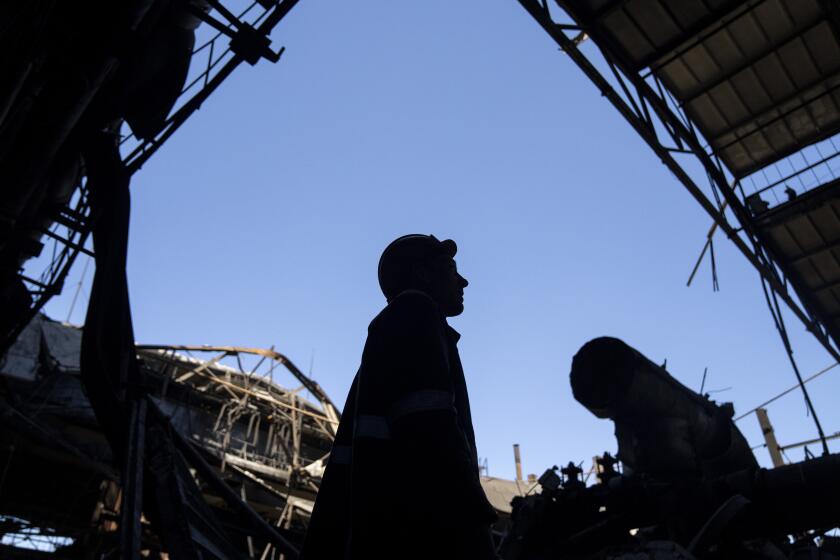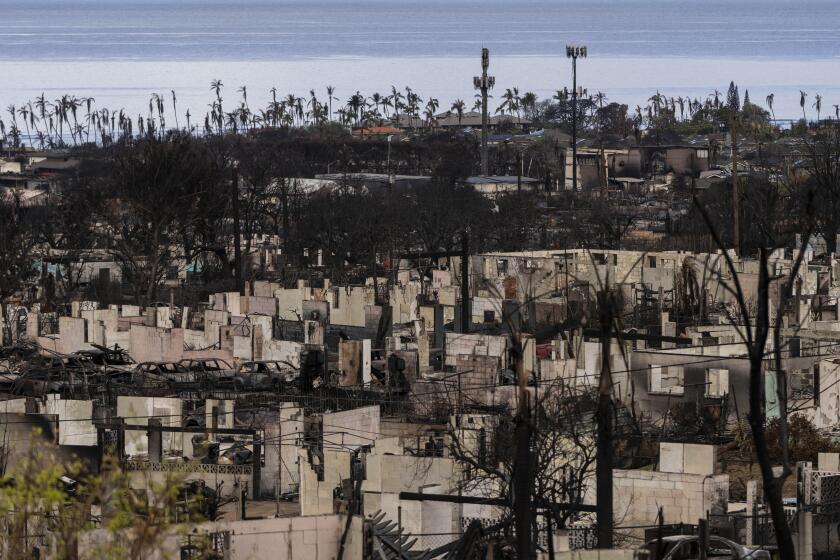Classified Iraq Data Released
Defending its prewar claims about Iraq, the White House took the unusual step Friday of releasing excerpts of a classified report providing details of intelligence given to the Bush administration in October indicating that Baghdad was amassing banned weapons and working to reconstitute its nuclear program.
The excerpts suggest that the CIA and other agencies were more concerned than they have previously acknowledged that the build-up to war might provoke Saddam Hussein to attempt terrorist strikes in the United States.
The report says Iraq “probably would attempt clandestine attacks against the U.S. homeland if Baghdad feared an attack.” It goes on to say that Hussein was likely to use biological weapons for such strikes and order his intelligence service to carry them out.
The release was part of a new effort by the White House to emphasize its broader case against Iraq, and take attention off the now-disputed claim President Bush made in his State of the Union speech that Baghdad was seeking uranium from Africa.
But the newly declassified material also underscored some questions about that charge because the text indicates that there was considerable doubt in the intelligence community about the uranium allegations before Bush’s Jan. 28 speech.
The excerpts also include wording that seems to undercut Bush administration claims before the war that Hussein had links to Al Qaeda. The report makes clear that the intelligence community believed cooperation with the terrorist network would represent an extreme step for Hussein.
“Saddam, if sufficiently desperate, might decide that only an organization such as Al Qaeda” could help him strike America, the report said. The scenario was presented in the context of the build-up to war.
The release of the material was the latest development in a feud between the CIA and the White House over who is to blame for Bush’s uranium allegation. CIA Director George J. Tenet has acknowledged that his agency, in vetting the president’s speech, should have ordered the wording removed.
But in testimony this week on Capitol Hill, CIA officials told senators that the agency raised objections to the language because of concerns about the underlying intelligence, and finally assented only when the White House proposed attributing the charge to British intelligence.
Briefing reporters at the White House on Friday, a senior administration official who said he was responsible for the speech-writing process disputed the CIA’s version of events.
He said that there were never “any flags raised about the underlying intelligence.” He said the allegation was attributed to British intelligence not in an attempt to circumvent CIA objections, but as part of a broader effort to connect allegations in the speech to specific sources. The uranium allegation had been included in a British dossier released in September, and the White House says it chose to cite that document rather than a comparable U.S. report that was still highly classified.
The official said Bush was unaware of any concerns about the uranium allegation.
“The president was comfortable at the time, based on the information that was provided,” the official said. Bush had been briefed on the U.S. intelligence report, but “I don’t think he sat down over a long weekend and read every word of it,” he said, adding: “The president of the United States is not a fact-checker.”
The official also said that in an earlier version of the speech the president had planned to say, “We also know that [Hussein] has recently sought to buy uranium in Africa.” In the final version, Bush said, “The British government has learned that Saddam Hussein recently sought significant quantities of uranium from Africa.”
White House officials said the uranium allegation may yet prove to be true.
Intelligence Consensus
The materials released Friday are eight pages of a 90-page document, called a National Intelligence Estimate, or NIE, that served as the basis for many of the administration’s claims about Hussein. The estimate is intended to represent a consensus of the CIA and other agencies on key questions -- in this case Iraq’s weapons programs.
Much of the excerpted wording had been released in a declassified “white paper” that was drawn from the NIE and made public in October. But there are significant differences.
Although both versions of the October report assessed that Baghdad possessed banned weapons, the classified text carries additional caveats, including one saying, “We lack specific information on many key aspects of Iraq’s WMD programs.” WMD refers to weapons of mass destruction.
Another key difference is that the white paper made no mention of Iraq’s alleged efforts to procure uranium from Africa. The NIE includes the allegations but in supporting materials separate from the central findings of the report.
In particular, the NIE cites foreign government reports that in early 2001 Niger was working on a deal with Baghdad to deliver “up to 500 tons of yellowcake,” or uranium ore. Other reports indicated that Iraq could be seeking uranium from Somalia and Congo.
The Niger information was based on documents obtained by Italian authorities later shown to be forgeries.
The NIE said that “most agencies” believed Iraq to be reconstituting its nuclear program. That finding was based largely on reports that Baghdad was reestablishing its “cadre” of nuclear scientists and assembling magnets, aluminum tubes and other necessary equipment.
Iraq could make a nuclear weapon “within several months to a year,” the report concluded, if it were able to acquire fissile material.
Dissent in the Ranks
But there was vocal disagreement on this point from the State Department’s intelligence bureau. In a dissenting view and footnote, the department said that it did not believe the aluminum tubes were for a nuclear program, and that the reports on uranium from Africa were “highly dubious.”
The excerpts also point to disagreements over prewar claims that Hussein was developing unmanned aerial vehicles to deliver biological weapons. The report notes that intelligence officials in the Air Force thought the size of the aircraft Iraq was developing made it more likely that their “primary role” would be reconnaissance.
Overall, although the report supports statements by Bush, Vice President Dick Cheney and others that Iraq was restarting its nuclear program, it also raises questions about why the White House included the African uranium charge in the State of the Union address.
Democrats have cited the allegation as evidence that the White House was hyping the Iraqi threat as it made its case for war. Stung by such criticism, the White House has tried to regain the offensive in recent days.
Cheney spoke to senior House Republicans this week in an effort to “rally the troops” and encourage them to be more forceful in defending the White House, a senior administration official said Friday.
News reports have said Mary Matalin, the veteran GOP strategist who left Cheney’s staff this year, is working with the White House again to shape strategy on the Niger dispute and other matters. The White House insisted Friday that she had continued to consult and that there has been “no change” in her role.
The newly released text offered a glimpse into concerns before the war about how Hussein might react to the build-up of American forces in the region and, ultimately, an invasion.
The finding that Baghdad “probably would attempt” clandestine attacks on the United States contrasts with more nuanced language the CIA released publicly in October.
At that time, the agency said that Baghdad appeared “to be drawing a line short of conducting terrorist attacks,” but that if Hussein considered a U.S. invasion unavoidable “he probably would become much less constrained in adopting terrorist actions.” That assessment was in an Oct. 7 letter to Sen. Bob Graham (D-Fla.), who was then chairman of the Senate Intelligence Committee.
The NIE cautioned that U.S. intelligence officials had “low confidence in our ability to assess when Saddam would use WMD.”
In contrast, the intelligence officials expressed “high confidence” in their assessments of Iraq’s possession of banned weapons.
The newly released pages serve as a reminder that the CIA and other agencies were convinced that Hussein had large stockpiles of chemical and biological weapons, as well as other munitions, though scant evidence of such items has been found in Iraq.
The NIE asserts that Hussein “probably has stocked at least 100 metric tons, and possibly as much as 500 metric tons” of chemical agents -- or between 110 and 550 tons -- “much of it added in the last year.”
The document also says intelligence agencies believed that Baghdad had chemical warheads for Scud missiles it had supposedly kept hidden.
*
Times staff writer Paul Richter contributed to this report.
More to Read
Start your day right
Sign up for Essential California for news, features and recommendations from the L.A. Times and beyond in your inbox six days a week.
You may occasionally receive promotional content from the Los Angeles Times.






